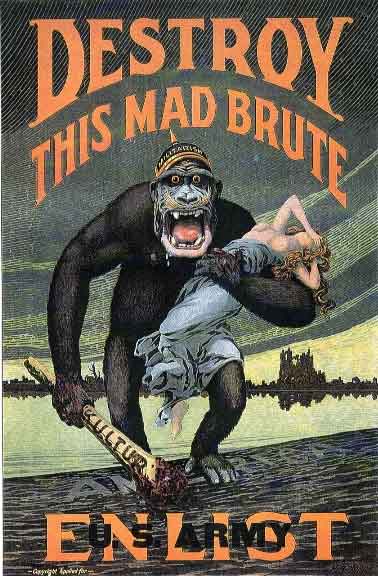
Wednesday, February 10, 2010
U.S. Made Propaganda
During WWII Propaganda was not used solely by Nazi Germany. The U.S. also used it to convey their point. The U.S. made multiple posters and cartoons illustrating either the Germans or Japenese being less then sensible. One example that fits this exactly is an image of Hitler as a pig. As you can see he is shown much bigger than the other pigs. He also has very sharp teeth to show his ferociousness.


In another poster put out by the U.S. there is a gorilla shown front and center with a crown to symbolize leadership. The gorilla is holding a women in a robe in one hand and in the other with a club in it. I personally believe the women is shown in a robe to symbolize vulnerability. It may also be noted that the gorilla is walking on water. On one part of the water it is calm and where the gorilla is standing the water has become wavy. It can also be seen that where the gorilla is standing there is the word America. And this was all just a enlistment poster for the U.S.
The last poster I found interesting had a double headed monster ripping apart New York city. One of the heads has red beaty eyes, fangs and blood coming out of their mouths with a war helmet that has a Swastika on it. The other head has the fangs and the blood too except wearing a Japanese war helmet. The monster has green skin in my opinion symbolizing difference and evil to some of the public viewing the poster. This also happens to be an enlistment poster with text simalar to the one above.
Finally, The most surprising thing was that two of three of these propaganda pieces were enlistment posters. Unlike the eternal Jew video these pieces were much clearer about making the German and Japanese forces look cartoonish while the Eternal Jew mad Jews look more like cold blooded merchants. Though, they both accomplished the same task. Making the viewer have a hatred to the opposing force.
Subscribe to:
Post Comments (Atom)




Fantastic job, Miles. These images certainly fit the bill as examples of zoomorphism and dehumanization--the last being closer to demonization! I really love your analysis of the images, as well, and your attention to the function of the message--the last two are specifically designed to compel the viewer to act: the second poster, to enlist to fight; and the third, to work harder to produce the materials needed to wage war against Germany and Japan.
ReplyDeleteJust a note: The second propaganda poster is actually from WWI, the ape--makes me think of a prototype for King Kong--representing Kaiser Wilhelm's Germany. Here's a link with more info:
http://commons.wikimedia.org/wiki/File:%27Destroy_this_mad_brute%27_WWI_propaganda_poster_%28US_version%29.jpg